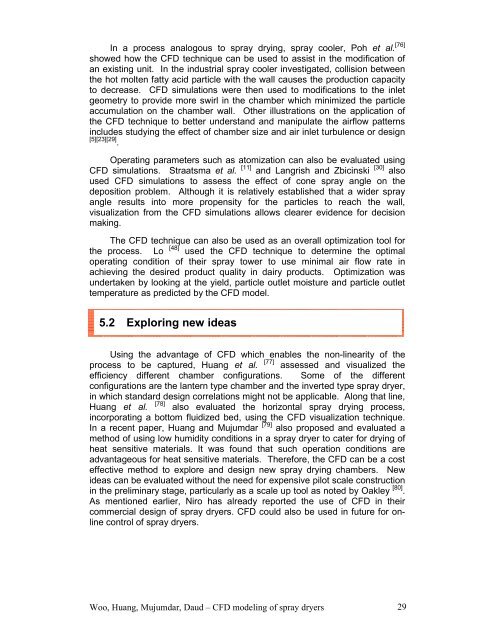Spray Drying Technology.pdf - National University of Singapore
Spray Drying Technology.pdf - National University of Singapore
Spray Drying Technology.pdf - National University of Singapore
You also want an ePaper? Increase the reach of your titles
YUMPU automatically turns print PDFs into web optimized ePapers that Google loves.
In a process analogous to spray drying, spray cooler, Poh et al. [76]<br />
showed how the CFD technique can be used to assist in the modification <strong>of</strong><br />
an existing unit. In the industrial spray cooler investigated, collision between<br />
the hot molten fatty acid particle with the wall causes the production capacity<br />
to decrease. CFD simulations were then used to modifications to the inlet<br />
geometry to provide more swirl in the chamber which minimized the particle<br />
accumulation on the chamber wall. Other illustrations on the application <strong>of</strong><br />
the CFD technique to better understand and manipulate the airflow patterns<br />
includes studying the effect <strong>of</strong> chamber size and air inlet turbulence or design<br />
[5][23][29] .<br />
Operating parameters such as atomization can also be evaluated using<br />
CFD simulations. Straatsma et al. [11] and Langrish and Zbicinski [30] also<br />
used CFD simulations to assess the effect <strong>of</strong> cone spray angle on the<br />
deposition problem. Although it is relatively established that a wider spray<br />
angle results into more propensity for the particles to reach the wall,<br />
visualization from the CFD simulations allows clearer evidence for decision<br />
making.<br />
The CFD technique can also be used as an overall optimization tool for<br />
the process. Lo [48] used the CFD technique to determine the optimal<br />
operating condition <strong>of</strong> their spray tower to use minimal air flow rate in<br />
achieving the desired product quality in dairy products. Optimization was<br />
undertaken by looking at the yield, particle outlet moisture and particle outlet<br />
temperature as predicted by the CFD model.<br />
5.2 Exploring new ideas<br />
Using the advantage <strong>of</strong> CFD which enables the non-linearity <strong>of</strong> the<br />
process to be captured, Huang et al. [77] assessed and visualized the<br />
efficiency different chamber configurations. Some <strong>of</strong> the different<br />
configurations are the lantern type chamber and the inverted type spray dryer,<br />
in which standard design correlations might not be applicable. Along that line,<br />
Huang et al. [78] also evaluated the horizontal spray drying process,<br />
incorporating a bottom fluidized bed, using the CFD visualization technique.<br />
In a recent paper, Huang and Mujumdar [79] also proposed and evaluated a<br />
method <strong>of</strong> using low humidity conditions in a spray dryer to cater for drying <strong>of</strong><br />
heat sensitive materials. It was found that such operation conditions are<br />
advantageous for heat sensitive materials. Therefore, the CFD can be a cost<br />
effective method to explore and design new spray drying chambers. New<br />
ideas can be evaluated without the need for expensive pilot scale construction<br />
in the preliminary stage, particularly as a scale up tool as noted by Oakley [80] .<br />
As mentioned earlier, Niro has already reported the use <strong>of</strong> CFD in their<br />
commercial design <strong>of</strong> spray dryers. CFD could also be used in future for online<br />
control <strong>of</strong> spray dryers.<br />
Woo, Huang, Mujumdar, Daud – CFD modeling <strong>of</strong> spray dryers 29

















